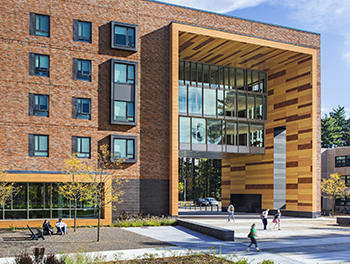Westfield State Debuts Collaborative Spaces
 WESTFIELD, Mass. — Westfield State University recently debuted the renovation of Ely Campus Center and the construction of its new student residence, University Hall. Following the design concepts of several universities across the U.S., the project team incorporated collaborative, flexible spaces to accommodate today’s students.
WESTFIELD, Mass. — Westfield State University recently debuted the renovation of Ely Campus Center and the construction of its new student residence, University Hall. Following the design concepts of several universities across the U.S., the project team incorporated collaborative, flexible spaces to accommodate today’s students.
Boston-based ADD Inc served as the architect on the project, working with Massachusetts State College Building Authority, which financed the project, as well as the university’s staff, faculty and students to create facilities that would meet the school’s needs. As such, Ely Campus Center’s renovation, totaling 37,600 square feet, includes major upgrades to the college’s student center, the expansion of the fitness area into a new two-story wellness center and the repurposing of basement space into a new, mixed-use student common area with a new entrance and outdoor terrace. The construction of University Hall totals 139,000 square feet and adds 411-beds to the campus.
“Students today require more collaborative and interactive learning environments, in and out of the classroom," said B.K. Boley, principal at ADD Inc, in a statement. “Based upon our surveys, they spend more time in the residence halls and campus centers than in any other locations on campus. We felt we had to go beyond enhancing the school’s facilities and services by designing ‘memorable’ spaces that truly enrich a student’s college experience and strengthen academic life.”
Ely Campus Center, initially built in 1968, underwent a much-needed $12.3 million renovation. ADD Inc designed the renovation to create a greater sense of space and transparency, removing most of the brick façade, installing double-glazed windows and doubling the exterior glass of the main floors. The new design introduced natural light and views of the main quad, as well as opened up corridors and repurposed underutilized basement space.
“It was some of the best money Westfield has spent on improving a campus facility since we were able to save the building,” said Jon Conlogue, Westfield State University’s executive director of residential services and campus life, in a statement.
The blue and white hues of the walls throughout the Ely Campus Center were chosen to maximize daylighting, while the interior furnishings were selected in deep oranges, greens and blues to bring energy to the space. The design team also chose multifunctional, modular furniture to accommodate different group sizes and uses.
The brand-new University Hall design created just as much flexibility for students living in the building. It features one-, four- and six-bedroom suites, including singles and doubles, each with a shared suite bath, living room and kitchenette.
The main goal of the project was to create diverse units with a variety of common spaces, ranging from a large multipurpose room to common lounges and kitchens to intimate light-filled lounges ideal for studying. The building’s Grand Arch is an all-glass, floor-to-ceiling, five-story archway with open spaces for student lounging and studying overlooking the campus, with views of Tekoa Mountain.
The architecture and interior design of the new building mimics the landscape of the surrounding mountains and woods, conveying a larger theme of a student’s journey walking through the woods toward the light. As such, ADD Inc designed the building to look like two trees fallen in the forest with a large arch that leads from a wooded overlook of Tekoa Mountain back to the campus quad.
The interior follows the same theme with student rooms and corridors designed to extend like branches out to study perches in the “tree canopy” space. Ground floor common areas and meeting rooms were made to feel like the forest floor with wooded ceilings and colorful furnishings reminiscent of wild flowers. The building’s exterior resembles bark, consisting of highly textured red and black brick, and the inside communal courtyard is made of wood-tone panels. The building’s interior space also features dark colors that gradually grow lighter down the corridors into the “branches” of the building.
The new residence hall was designed to meet LEED Silver certification, as the new space features recycled and regional materials, highly sustainable interface carpet and reclaimed wood elements used for the reception desk and for the large bay window seat on the ground floor.
